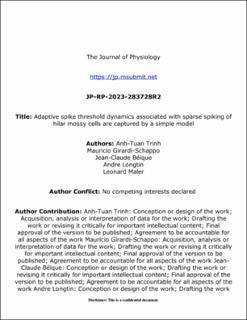| dc.contributor.author | Trinh, Anh Tuan | |
| dc.contributor.author | Girardi-Schappo, Mauricio | |
| dc.contributor.author | Béïque, Jean-Claude | |
| dc.contributor.author | Longtin, André | |
| dc.contributor.author | Maler, Leonard | |
| dc.date.accessioned | 2024-03-07T09:07:43Z | |
| dc.date.available | 2024-03-07T09:07:43Z | |
| dc.date.created | 2023-10-03T12:50:20Z | |
| dc.date.issued | 2023 | |
| dc.identifier.citation | Journal of Physiology. 2023, . | en_US |
| dc.identifier.issn | 0022-3751 | |
| dc.identifier.uri | https://hdl.handle.net/11250/3121384 | |
| dc.description.abstract | Hilar mossy cells (hMCs) in the dentate gyrus (DG) receive inputs from DG granule cells (GCs), CA3 pyramidal cells and inhibitory interneurons, and provide feedback input to GCs. Behavioural and in vivo recording experiments implicate hMCs in pattern separation, navigation and spatial learning. Our experiments link hMC intrinsic excitability to their synaptically evoked in vivo spiking outputs. We performed electrophysiological recordings from DG neurons and found that hMCs displayed an adaptative spike threshold that increased both in proportion to the intensity of injected currents, and in response to spiking itself, returning to baseline over a long time scale, thereby instantaneously limiting their firing rate responses. The hMC activity is additionally limited by a prominent medium after-hyperpolarizing potential (AHP) generated by small conductance K+ channels. We hypothesize that these intrinsic hMC properties are responsible for their low in vivo firing rates. Our findings extend previous studies that compare hMCs, CA3 pyramidal cells and hilar inhibitory cells and provide novel quantitative data that contrast the intrinsic properties of these cell types. We developed a phenomenological exponential integrate-and-fire model that closely reproduces the hMC adaptive threshold nonlinearities with respect to their threshold dependence on input current intensity, evoked spike latency and long-lasting spike-induced increase in spike threshold. Our robust and computationally efficient model is amenable to incorporation into large network models of the DG that will deepen our understanding of the neural bases of pattern separation, spatial navigation and learning. | en_US |
| dc.language.iso | eng | en_US |
| dc.publisher | Wiley | en_US |
| dc.rights | Navngivelse 4.0 Internasjonal | * |
| dc.rights.uri | http://creativecommons.org/licenses/by/4.0/deed.no | * |
| dc.title | Adaptive spike threshold dynamics associated with sparse spiking of hilar mossy cells are captured by a simple model | en_US |
| dc.title.alternative | Adaptive spike threshold dynamics associated with sparse spiking of hilar mossy cells are captured by a simple model | en_US |
| dc.type | Peer reviewed | en_US |
| dc.type | Journal article | en_US |
| dc.description.version | acceptedVersion | en_US |
| dc.rights.holder | © 2023 The Physiological Society | en_US |
| dc.source.pagenumber | 0 | en_US |
| dc.source.journal | Journal of Physiology | en_US |
| dc.identifier.doi | 10.1113/JP283728 | |
| dc.identifier.cristin | 2181303 | |
| cristin.ispublished | true | |
| cristin.fulltext | postprint | |
| cristin.qualitycode | 2 | |

